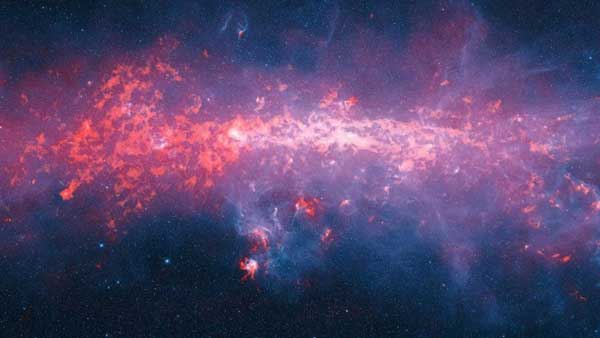
Berlin, Germany (BBN)-Astronomers have completed a detailed map of where dense, very cold gas - the stuff of which new stars are made - is found across the Milky Way.
Staring into space from an altitude of 5,100m in the Atacama desert, the Apex telescope has imaged as much of our galaxy as it can see, reports BBC.
It has sampled this vast, thin strip of the southern sky using radiation that sits between radio and infrared waves.
The detector is effectively a highly sensitive, super-chilled thermometer.
Tiny changes in temperature are registered by a bank of 295 sensors, kept at less than 0.3 degrees above absolute zero, called the Large Bolometer Camera (Laboca).
This instrument is at the heart of Apex - the Atacama Pathfinder Experiment - a 12m telescope that has been operating on Chile's high Chajnantor Plateau for 10 years.
The newly completed map, called Atlasgal (the Apex Telescope Large Area Survey of the Galaxy), has already produced 70 scientific papers.
Its first big tranche of data was released in 2009.
Today's release covers an area 140 degrees long and three degrees wide: more than four times the span of the previous iteration. It is also a much more precise, detailed map.
"Atlasgal provides exciting insights into where the next generation of high-mass stars and clusters form," said Timea Csengeri from the Max Planck Institute for Radio Astronomy in Germany.
The survey complements existing data on the northern Milky Way, collected by other telescopes.
But the southern view of our galaxy is of particular interest because it includes the galactic centre.
It also means that promising regions of the map can be investigated in much greater depth by Alma, the powerful, 66-strong cluster of antennae that sits on the same plateau and also peers southwards.
The Atlasgal team has combined their data, based on radiation with a wavelength of 0.87mm, with measurements from two space telescopes: similar but lower-resolution images from Planck, and shorter-wavelength infrared data from Spitzer.
These different layers have been superimposed in a huge, downloadable image (displayed in part above) which shows the Atlasgal data in red, the Plank data in fainter red and the Spitzer measurements in blue.
"Atlasgal has allowed us to have a new and transformational look at the dense interstellar medium of our own galaxy, the Milky Way," said Leonardo Testi from the European Southern Observatory.
"The new release of the full survey opens up the possibility to mine this marvellous dataset for new discoveries. Many teams of scientists are already using the Atlasgal data to plan for detailed Alma follow-up."
Other astronomers can download Atlasgal data from ESO's website and the work is described in the journal Astronomy and Astrophysics.
BBN/SK/AD